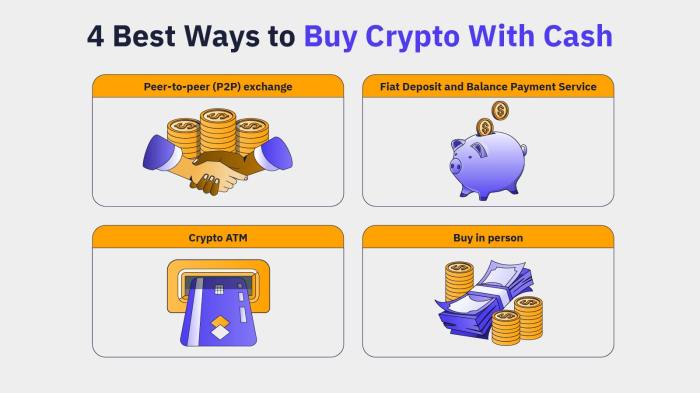Ready to dive into the world of cryptocurrency? In this guide on the best way to buy crypto, we’ll explore key factors, platform types, payment methods, and wallet options to help you navigate the complex landscape of digital assets.
From understanding security features to choosing the right payment method, this guide will equip you with the knowledge needed to make informed decisions when entering the crypto market.
Factors to Consider
When choosing a platform to buy crypto, there are several key factors to consider that can impact your overall experience and security. One of the most important factors is the security features offered by the exchange, as protecting your funds and personal information is crucial in the crypto world.
Importance of Security Features
Security should be a top priority when selecting a reliable crypto exchange. Look for platforms that offer two-factor authentication, cold storage for funds, and encryption protocols to safeguard your account from hacking attempts. Additionally, consider the exchange’s track record with security breaches and how they handle customer funds in case of unforeseen events.
Comparison of Fees
Another important factor to consider is the fees charged by different platforms for buying crypto. Compare and contrast the fees for depositing, trading, and withdrawing funds across various exchanges to ensure you are getting the best value for your money. Keep in mind that high fees can significantly impact your purchasing power and overall profitability when trading crypto assets.
Types of Platforms

When it comes to buying cryptocurrencies, there are different types of platforms available for users to choose from. These platforms can vary in terms of their functionality, user experience, and security features. It’s important to understand the various options available before deciding where to buy crypto.
Centralized Exchanges vs. Decentralized Exchanges
Centralized exchanges are platforms that are operated by a company or organization. These exchanges act as intermediaries between buyers and sellers, holding funds and executing trades on behalf of users. Some advantages of using centralized exchanges include higher liquidity, a wide range of trading pairs, and enhanced security measures. However, centralized exchanges are also susceptible to hacking attacks and regulatory pressure.On the other hand, decentralized exchanges (DEX) operate without a central authority, allowing users to trade directly with each other using smart contracts.
DEX platforms offer greater privacy, security, and control over funds since users retain ownership of their private keys. However, decentralized exchanges may have lower liquidity, slower transaction speeds, and limited trading pairs compared to centralized exchanges.
User Experience and Buying Process
The user experience on different platforms can greatly impact the buying process for cryptocurrencies. Centralized exchanges often provide a more intuitive user interface, making it easier for beginners to navigate the platform and execute trades quickly. These platforms may also offer additional features such as margin trading, lending, and staking to enhance the user experience.Decentralized exchanges, while offering increased security and privacy, may have a steeper learning curve for novice users due to the complexity of using smart contracts and managing private keys.
Users on DEX platforms need to be more cautious and ensure they are interacting with legitimate trading pairs to avoid falling victim to scams or fraud.Overall, the choice between centralized and decentralized exchanges ultimately depends on individual preferences regarding security, privacy, ease of use, and available trading options. It’s important for users to conduct thorough research and consider their own risk tolerance before selecting a platform to buy cryptocurrencies.
Payment Methods
When it comes to buying crypto, choosing the right payment method is crucial for a smooth and secure transaction process. Different crypto exchanges accept various payment methods, each with its own set of pros and cons. Let’s explore the common payment methods accepted by crypto exchanges and how to choose the best one for you.
Credit/Debit Cards
Using credit or debit cards is one of the most popular payment methods for buying crypto. It offers convenience and instant transactions, allowing you to quickly purchase your desired cryptocurrencies. However, it may come with higher fees compared to other payment options. Additionally, some banks may restrict crypto-related transactions, so make sure your card is crypto-friendly.
Bank Transfers
Bank transfers are another common payment method accepted by crypto exchanges. This method is usually preferred for larger transactions due to lower fees compared to credit/debit cards. However, bank transfers may take longer to process, delaying your purchase. It’s important to double-check the exchange’s banking details to avoid any errors in the transfer process.
Other Payment Options
Apart from credit/debit cards and bank transfers, crypto exchanges may accept other payment options such as e-wallets, PayPal, and even cash payments in some cases. Each alternative payment method comes with its own set of advantages and limitations, so it’s essential to consider factors like security, fees, and processing times when choosing the right option for you.
Wallet Options

When it comes to storing your cryptocurrencies, having the right wallet is crucial. There are various options available, each with its own set of features and security implications. Let’s explore the different types of cryptocurrency wallets to help you make an informed decision.
Hot Wallets (Online)
Hot wallets are connected to the internet and are convenient for frequent trading or transactions. They are accessible from any device with an internet connection, making them easy to use. However, being online also makes them more susceptible to hacking and security breaches. It’s essential to use strong security measures like two-factor authentication to protect your assets when using a hot wallet.
Cold Wallets (Offline)
Cold wallets, on the other hand, are offline storage solutions for your cryptocurrencies. This makes them less vulnerable to cyber attacks compared to hot wallets. Hardware wallets, paper wallets, and even offline computer wallets are examples of cold wallets. While cold wallets provide enhanced security, they are less convenient for regular transactions due to the need to transfer funds online when needed.
Choosing a Secure Wallet
When selecting a wallet to store your crypto assets, prioritizing security is paramount. Look for wallets with robust encryption features, two-factor authentication, and a strong reputation in the crypto community. It’s also essential to keep your private keys secure and never share them with anyone. Remember, the safety of your investments depends on the security of your chosen wallet.
Final Thoughts
In conclusion, by following the tips and insights shared in this guide, you’ll be well on your way to purchasing crypto assets with confidence and security. Whether you’re a novice or experienced investor, taking the time to understand the best practices for buying crypto can make all the difference in your journey.